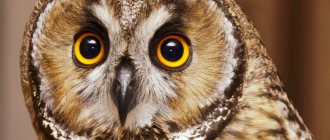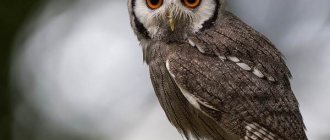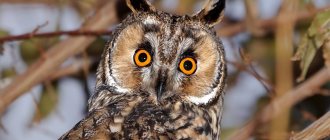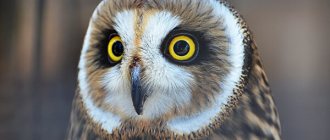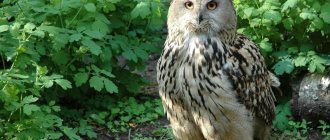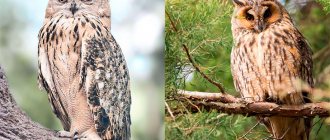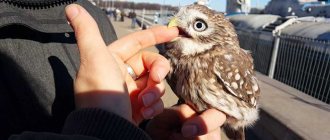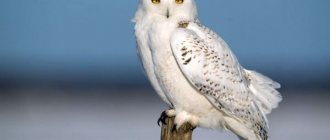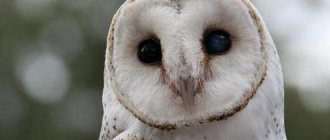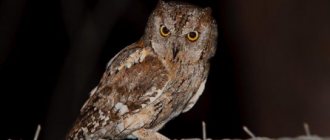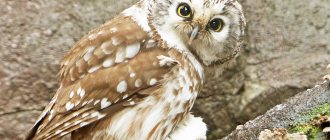The owl is a bird of prey from the order Owls. It includes more than two hundred species of birds. Owls are distributed throughout the globe, they live in mountains, forests, steppes, on sea coasts and even in the Far North. Most of them are nocturnal and hunt in the dark. In the article we will learn in detail about the lifestyle of owls, what they eat, breeding characteristics and rules of keeping them in a house or apartment.
Owl sitting on a tree branch
Features and lifestyle
Owls are not like most birds. Due to the specific appearance of these birds, representatives of other avian orders can be immediately distinguished.
- Owls can turn their heads 270°C. This is possible due to the fact that the carotid arteries are close to the lower jaw.
- Owls differ from other birds by having a facial mask. Their large round eyes are located in front, and not on the sides. Scientists have proven that representatives of the owl order do not distinguish colors and see the world in black and white.
- Birds see quite well both during the day and at night. An owl's pupil contracts and dilates as it breathes and depending on the level of lighting.
- These birds of prey have very sensitive hearing. Their ears are quite large and are protected from the action of the external environment by skin and feathers.
- The wings are rounded at the edges and curved towards the body. Some species have fringes on the outer webs of the first wing feathers - this allows them to fly without making noise. Subsequent feathers are slightly longer; the tail feathers are located in the tail and curve downwards. Owls' feet are almost entirely protected by feathers.
- Almost all bird species have dull colors in gray-brown tones, which camouflage them well against the background of the night forest. The bird's peculiarity is its long curved claws and hook-shaped beak. The latter has a small hook at the end, with the help of which the birds make peculiar sounds similar to clicking.
- Representatives of owls differ in some skeletal features. There are small processes on the bones, there is a triple articulation of the lower jaw with the skull, a short phalanx of the third finger, and pits on the bony edge of the chest.
It is known that owls are mostly sedentary and do not like long flights. They are more active at night, and during the day they rest in the nest or sit on a branch. In flight, an owl can reach speeds of up to 80 km/h.
How long do they live?
Wild owls can live from five to fifteen years. Age largely depends on the number of enemies, weather conditions and the volume of food supply. The eagle owl lives longer than other relatives - 15-20 years.
Little owl hid near the stones
What do they eat
The owl menu mainly includes food of animal origin. These predators can go without water for a long time, as they maintain water balance with the help of the blood of killed animals. Eagle owls and some large owls can grab and kill a hare, fox, ferret and other small birds. Polar owls hunt rodents and stoats. Spine-legged birds, elf owls and other compact-sized owls catch and eat insects.
INTERESTING FACT. Many owls make provisions for the winter, which they store in a nest or in a tree crevice. When hunting, owls silently fly up to their prey and grab it. Sometimes they scream to scare away potential prey and cause it to flee. Owls hunt other birds less frequently.
Thanks to their very sensitive hearing, these birds of prey hear the movements of rodents and small mammals. Polar owls are able to hear the movement of a mouse even under a layer of snow several meters thick. It is also interesting that this species can hunt both day and night. The polar owl's diet includes lemmings, ducks, and fish.
Sexual demorphism
Some species of owls exhibit reverse sexual demorphism, where females are larger than males. Scientists explain this by saying that it is easier for a lighter and more dexterous male to catch prey, and a well-fed female will be able to remain without food longer, hatching her offspring.
It is almost impossible to distinguish females and males by the color of their plumage and external characteristics. In polar owls, females are distinguished by the presence of dark streaks, which are absent in males.
Natural enemies
The presence of natural enemies in owls depends on their habitat. In mountainous areas these can be eagles and vultures, in the forest-steppe zone - hawks and other birds of prey. Young polar owls are sometimes attacked by arctic foxes and skuas. Large eagle owls have practically no natural enemies. Occasionally it happens that their chicks are attacked by bears or wolves.
A hawk attacks an owl in a field
In addition to animals and birds of prey, owls have more insidious enemies - helminths and parasites. But the greatest damage to the owl population is caused by people who destroy their natural habitat - forests and wild steppes.
Mysterious bird eagle owl
The eagle owl is a prominent representative of the family of birds of prey in the order Owls. This bird has a good hunting instinct and excellent hearing.
The life of a night robber is mysterious and multifaceted; he is credited with extraordinary vigilance and at the same time complete blindness. In the dark, this bird determines the location of its prey with absolute precision and purposefully attacks its prey.
Types of owls
The order of owls is divided into two families: true owls and barn owls. The following are considered real owls:
- Eagle owls - they are large in size, have feather appendages in the form of “ears” on the head and a brown-red color of plumage with fine variegation. The body size of eagle owls is 34-76 cm in length.
- Owls – Their distinct features are large feathered “ears,” a fuzzy face, and bald, unfeathered toes. Cutworms have variegated plumage with a gray, brown or rufous base color.
- Tawny owls do not have “ears” made of feathers, but the front part is clearly formed. Birds are gray or red in color with dark brown patches.
- Neotropical owls include three species of birds.
- Tawny owls are predators with distinct “ears” of feathers and are found in forests located in the south and center of the North American continent.
- Fish owls are found near large bodies of water and hunt for fish.
- The Western Armyworm is a species native to western North America.
- The Cuban armyworm is a unique species that lives only in the Cuban archipelago.
- White-faced cutworms include two species, distinguished by light gray feathers with brownish streaks.
- The African horned owl is a unique species that lives only in African regions.
This is what a white-faced cutworm looks like.
Different types of cutworms live mainly in Europe, America and Asia, as well as in Africa. Different types of scops owls are preferred in European regions. The habitats of eagle owls are in Eurasia, America and Africa.
The barn owl subfamily includes:
- The passerine owl includes about three dozen species; they have modest sizes, a long tail and short wings. Their facial part is not pronounced, their eyes are not too large, and there are no “ears” made of feathers.
- Spine-footed owls are characterized by the presence of sparse bristle-like feathers covering their toes. Body sizes reach 25-55 cm.
- Great-footed owls are divided into several subspecies. They resemble owls, but differ from them in more ruffled plumage and fingers that are covered by a feather.
- Forest owl - its striking differences are: light stripes on the wings, strong paws, which are covered with light plumage. They grow up to 28 cm in length.
- Owls are divided into three species and prefer steppe zones.
- The Andean Whiskered Owl is an endemic species that lives on the slopes of the Andean Mountains.
- The hawk owl is about 34 cm long and has yellow eyes and beak. There are no feather processes on the head.
- Elf owl - adult birds have a body 12-16 cm long and weigh only 65 g. The head is noticeably larger than the body, there are no “ears”, it lands in a vertical position.
- Paluan owl - reaches a length of 34 cm, a striking feature is its small rounded wings.
Habitats
The owl and the owl are sedentary inhabitants of the forest. For living and nesting, they choose hard-to-reach places with sufficient food supply. This can be a coniferous forest, a forest-steppe, a taiga, a desert, and even mountain peaks. They adapt well to different climatic conditions and can withstand heat and frost.
These representatives of the wild cannot stand proximity to humans, therefore they nest in remote areas not affected by human activities.
The habitat of the winged predator is extensive: it extends across most of Eurasia, covers the northern part of Africa, and reaches the borders of Southern China and India.
In North America, a representative of the owl order, the great eagle owl, is distributed throughout the country.
On the territory of Russia, this bird lives in the Ulyanovsk, Chelyabinsk, Sverdlovsk, Saratov regions, the Komi Republic, as well as in some other regions.
Mating season and singing
The age at which individuals become sexually mature varies among species, but on average individuals begin to mate at 12–24 months of age. The mating season begins for owls in December-January. By the beginning of spring, all adults already have partners. This is especially noticeable during the day, when another is sure to sit next to one owl. Not all species have a breeding season in winter; for example, the tawny owl looks for a partner in October-November; in scops owls and cutworms, pairing begins in March.
Owls attract partners by chatting. In birds that are active during the day, the mating season is characterized by the presence of various sudden movements that attract the eye. Short-eared, polar and hawk owls make long flights over the nesting site - they soar, often flap their wings, and sometimes make loud pops.
Along with calling, some owls attract a mate by the flickering of a white patch on their neck. They make sounds by moving their throats so that the feathers rise and make flickering movements in the dark. Basically, the vocalization of owls looks like a series of monotonous dull notes or a sharp calling cry.
Some birds perform a duet mating song, where the male and female call in turns. The long-eared owl, the common and fish owls have this feature. Each sound is pronounced at strictly designated intervals. The male starts the song, the next sound is pronounced by the female, then again by the male, and so on.
Pair formation in owls and mating are extended over time, so the mating season lasts several months.
INTERESTING FACT. During defense or when showing aggression, owls begin to click their beaks. Some representatives, for example, the great gray owl, not only produce clicks, but also hiss.
Video about what voices different representatives of owls make:
Hatching chicks
The female is larger in size than the male. According to one version of scientists, nature in this way gives her the opportunity to better retain heat when hatching offspring. Males, with their smaller size, are more agile when catching prey. They have to hunt a lot to feed themselves, their darling and their chicks.
These predators do not build nests; they live in rock crevices, tree hollows, and in old nests of other birds. The eggs are laid round, smooth, and white. The chicks appear after a month - blind, covered with thick down.
Gray owl with chicks.
Reproduction and offspring
Owls rarely build nests; they mainly try to find a convenient hollow, old nesting sites of large birds, or a crevice in the rocks. Tawny owls can live in artificially created houses. Little owls love to live near human habitation: in attics and barn roofs. Owls of different species can produce offspring from 1 to 3 times a year. This factor also depends on the amount of food. Some of them form pairs for life, others - for one season.
The female lays eggs on the surface of the nest without any bedding. The clutch may contain 3-10 white spherical eggs. If the chicks do not have enough food, the older and stronger owlets may eat the smaller or weaker ones. If there is enough food, then chicks of different age groups can coexist normally in the nest. The females do the incubation, and the chicks are fed by both parents. Father and mother bring food to all the owlets, but pay more attention to the oldest ones.
Owl chicks covered with down
Young owls mainly die due to a lack of food supply. In some periods there is a shortage of rodents, hares and other small animals. In “hungry” years, up to 28% of chicks can die. Sometimes owlets themselves fall out of the nest or fly out prematurely. Then they often become prey for foxes, raccoons and ferrets. Parents continue to feed the chicks even after leaving the nest.
When danger appears, the adults notify the chicks with a signal. The owls, in turn, stop making noise and try not to move. When young animals quarrel or fight, a loud, dissatisfied squeal and squeak is heard.
The meaning of owls in nature
Owls make a great contribution to the stability of natural balance. They destroy field pests, sick birds and small animals. Owls actively participate in natural selection, which has a beneficial effect on the gene pool of the animal world.
Birds also help propagate shrubs, trees and plants by transporting seeds over long distances. Owl droppings are a nutritious organic fertilizer.
Owl with prey in its beak
IMPORTANT INFORMATION. Unfortunately, human activity has led to a significant reduction in wild forests - the natural habitat of owls. This led to the fact that a number of species were included in the Red Book.
Nutrition
These birds are night hunters. They usually feed on insects and small rodents - mice, voles and others. They see well in the dark, they have very sensitive hearing, and their flight is almost silent. Thanks to these qualities, their hunting is almost always successful.
Owls use several hunting methods:
- They fly quietly through the night forest, sometimes they scream, scaring small animals, and when they hear a rustle, they quickly grab their prey.
- They sit quietly on a tree and listen, and when they hear a squeak or rustle, they quickly fly off the branch and grab their prey.
- Fish owls catch fish with their paws directly from the water and hold them with sharp claws.
Only some owls go hunting during the day, for example, polar, hawk and pygmy owls.
Owl in mythology
In ancient times, the owl was considered the embodiment of evil spirits; many peoples associated it with the other world. People still believe in some superstitions. The British, for example, have long believed that the owl brings bad news. Seeing an owl or hearing its cry was a sign that one of the family members would soon die.
In Ancient Greece, the owl was considered a symbol of wisdom. This is confirmed by numerous frescoes and images. The goddess of wisdom, Athena, was depicted with an owl on her shoulder. In India, on the contrary, a stupid person was associated with this bird.
Among the Slavic peoples, owls were considered servants of “dark forces”; mystical abilities were attributed to them. The appearance of an owl near a home was a harbinger of major troubles, so people tried to drive these birds away from their homes. However, images of owls were often used as amulets. It was believed that they contributed to prosperity and helped preserve valuable things.
In ancient Rome, it was believed that witches could take the form of an owl, fly into the bedroom and drink the blood of sleeping people. For example, Ovid mentions a bird in his notes on witchcraft. Virgil also wrote about the owl in the Aeneid. This bird sat on the roof of Carthage and warned Dido about betrayal and death.
One of the first mentions of an owl is in the Bible. The prophet Isaiah imagined Babylon as a habitat for owls and unclean creatures.
INTERESTING FACT. One of the first images of an owl was found in the Chauvet Cave, located in southern France. Archaeologists have found that the sample is about 36 thousand years old.
Keeping owls at home
Recently, it has become very fashionable to keep a wild bird or animal at home. Many people choose owl representatives for this purpose. Birds of prey are attracted by their beautiful large eyes and fluffy plumage. However, in most cases, people are not aware of all the risks of having an owl in their home. To buy a bird, they go to the spontaneous “Bird Market”. Local sellers, wanting to make money, assure buyers that the birds were raised exclusively in a nursery and are absolutely healthy. In fact, it often turns out that the owl was caught in the wild and has a whole “bouquet of diseases.”
Feeding an owl at home
HELPFUL INFORMATION. It is worth thinking carefully about whether you want to have a pet that constantly needs animal food, often screams at night, leaves scratches on its body and can cause serious injury.
Before buying a live owl, you should get acquainted with the features of keeping it in a house or apartment:
- The owl's activity occurs in the late evening, at night and at dawn. In captivity, the bird will behave the same way - at this time it will fly, rattle and scream, especially during the mating season.
- For an owl you will have to buy chickens, mice, and quails. Regular raw meat will not work here; for proper digestion, the owl needs to swallow the prey whole.
- Owls produce a lot of litter, especially large ones.
- Birds' claws are long and sharp, so you need to be prepared for the fact that after close interaction with them, scratches will remain on the body.
In an ordinary city apartment, small birds can feel comfortable: owls, long-eared owls or barn owls. Large eagle owls or owls require a lot of space to fly, which cannot be provided in a standard-sized room. If you place a large predator in an apartment, it will constantly feather the feather.
IMPORTANT INFORMATION . You cannot keep an owl in a cage, otherwise the bird will break its feathers on the bars, injure its beak and damage its legs. For these feathered predators you need to prepare a separate place where they will feel safe.
It is important to monitor your pet's health. Signs of illness in an owl are:
- loss of appetite;
- sitting in one place with eyes closed;
- partial covering of the eyes with the lower eyelid;
- ruffled and dirty feathers, especially under the tail.
Diseases in birds progress very quickly, so if you have one of the symptoms, do not delay a visit to the veterinarian.
Watch interesting facts about owls in this entertaining video:
How to prepare a room for keeping an owl
In captivity, owls love to play with various little things, so first of all you should remove all objects that it could damage or knock over in flight. Lace window curtains must be replaced with thick curtains, otherwise the bird will get entangled in them and break its legs or wings. Also, you should not keep large mirrors in the room, which could seriously injure an owl trying to fly through the glass.
Wooden or metal sticks with soft upholstery, such as carpet or artificial grass, should be nailed to the wall. You also need to provide containers for bathing; owls are very clean and love to wash themselves. Plastic trays with high sides are suitable for this.
You definitely need to think about where to get food for the owl. The average individual eats 2-3 mice per day. The basis of the diet should be freshly killed carcasses of rodents and birds, but sometimes it is necessary to give live food. It is expensive to buy rodents at the Bird Market or a pet store, and they are not always available in the required quantity. Therefore, it is better to find breeders and buy “food” from them in bulk or start breeding rodents yourself. Quails are fed to owls with caution and the entrails, legs and head are removed from the carcass before eating. Quails are often carriers of infections that can be transmitted to your pet.
Enemies
The polar fly also has enemies, these are foxes, arctic foxes, and skuas, so caution and attentiveness will not hurt her. She makes sharp, abrupt and rather loud cries - “kra-au” and “ki-ki”. Its flight is silent, calm and maneuverable.
How to choose an owl
An owl should only be purchased from a specialized nursery, where all animals are ringed. The bird must have a document with the same number stamped on the ring. This will protect you from acquiring a sick owl and eliminate the risk of its removal due to legislation according to which it is prohibited to keep wild birds in the house. After purchasing an owl, you need to show it to a veterinarian and get tested.
The nurseries mainly breed long-eared and short-eared owls, various types of tawny owls, and little owls. When choosing an owl, you need to take into account its size and the dimensions of the allocated room. Small predators are no worse than large individuals; they are just as playful and sociable.
It is better to buy young individuals, they adapt better to new conditions and get used to being handled. It is quite easy to distinguish a chick from an adult; it is covered with faded down; older owlets begin to acquire feathers, but their tail length is shorter. To transport a purchased owl, it is better to take a closed large box, lay a soft cloth on its bottom and make several holes for air to enter.
The owl scattered feathers around the room
Adaptation to a new home
After arriving home, you need to put the box near the place set up for the pet, open it and leave the room. Let the owl fly out of it on its own, calmly look around and get used to the situation. After two hours, you can offer your pet water and food. Little owlets do not yet know how to tear apart mouse carcasses on their own, so it is better to chop them up in advance. At first, it is better not to pick up your pet, not to make loud sounds or make sudden movements. The next day, food can be offered by hand so that the pet gets used to the owner faster. About 10 hours after eating, the owl should regurgitate the undigested skin and bones of its prey. If this does not happen, you should be wary - the bird may have digestive problems. It is also necessary to check whether there is blood in the regurgitated mass or in the stool. In a healthy owl, it is a black solid content surrounded by a white liquid. If the droppings have a foul odor or an unnatural color, it is worth checking with a veterinarian.
Breeding in captivity
If desired, the owner of a pair of owls can start breeding this interesting bird. Often such activities turn into quite profitable businesses. You need to start breeding by creating a comfortable nest. It can be made from a log with a hollow or from a cabinet with a cut hole. At the bottom of the hollow, a bedding is made of fluff, dry grass and feathers. The owl does not lay eggs all at once, but at intervals, so after all the chicks hatch, they will be of different ages. Newly hatched chicks need to be given more attention and their health monitored. After a month, the juveniles will try to fly.
It is better to give the chicks to a new owner at the age of two months. But before that, the owlet needs to become tame. To do this, wear thick gloves so that the bird does not injure your hands with sharp claws, and take the owlet in your hands. This must be done carefully so as not to scare the chick. In this case, it is advisable to talk to him in a quiet, gentle voice, showing that you are friendly. Experienced breeders recommend starting taming owlets at two weeks of age. When the time comes to give the baby away, he will already be completely tame.
Diet of raptors
Owls feed on insects, reptiles, rodents, ground squirrels, and birds. They don’t even disdain their relatives. Large representatives living near water bodies can fish from the water surface.
Species that do not fly to warmer climes make a “winter reserve” for themselves, storing captured rodents in rock crevices and tree hollows.
Happy hunting.
Nocturnal predators swallow their prey whole or tear it into pieces if it is large. After a few hours, everything that has not been digested (fur, bones, feathers) is regurgitated.
